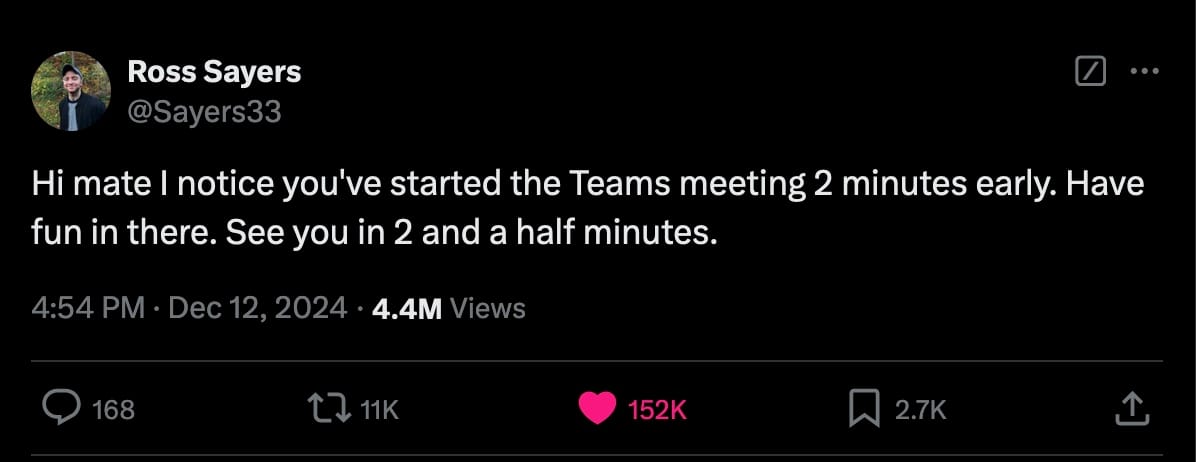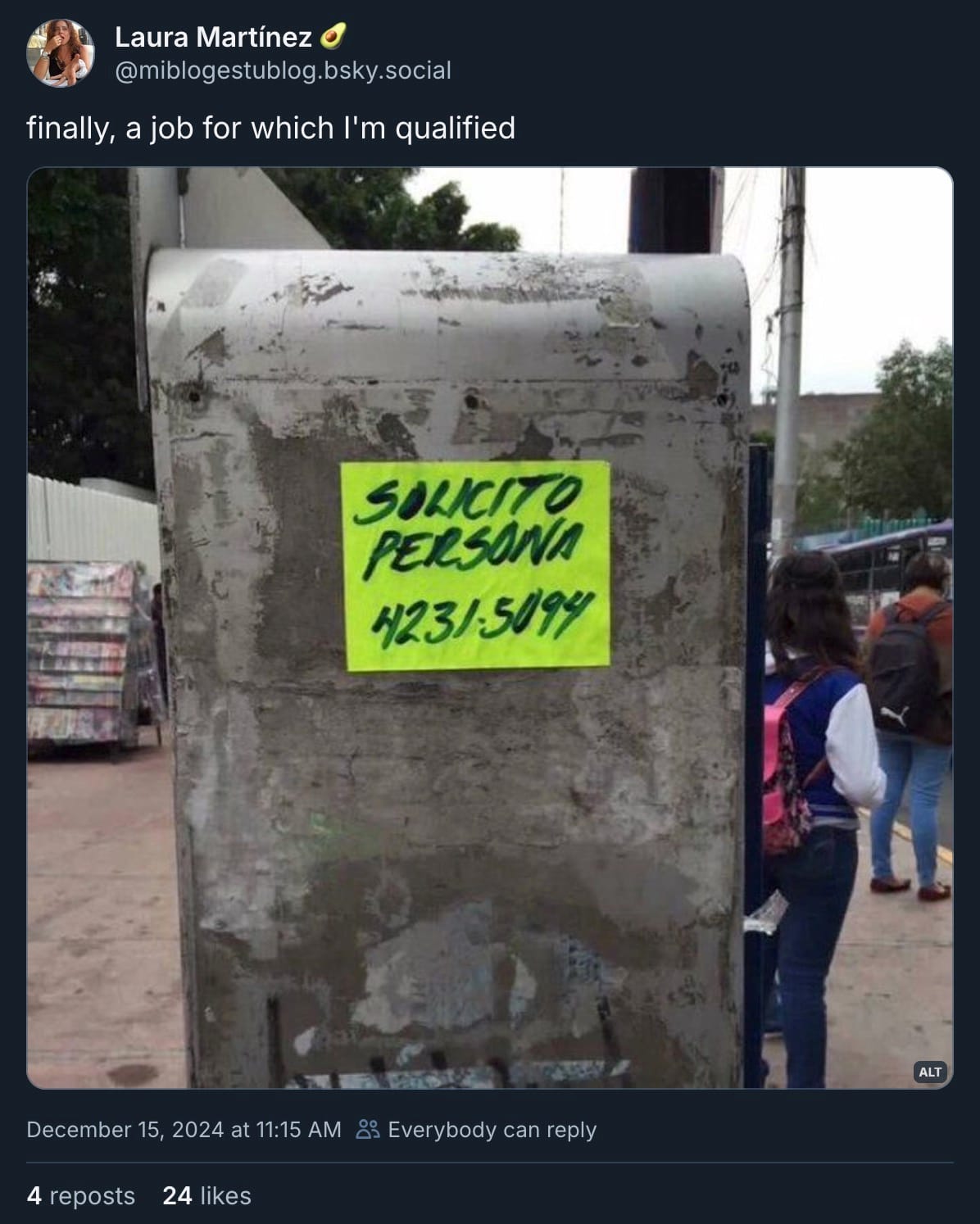Updates from Adam Isacson (December 15, 2024)
Hi, this is Adam. If you're receiving this message, it means you signed up on my website to receive regular updates. If you'd like to stop getting these, just follow the instructions further down.
This may be the last update I'll send until the weekend of January 11-12. Next week, the last full week before Christmas, is a slow one, and I hope to hunker down and finish a big project (coding, not writing) that I've had on the shelf for months. I'll unveil it at some point next year. So I don't plan to produce much next week, other than a Border Update. If I do send another message next weekend, it will be thin.
This one is reasonably thick, though: in addition to the Border Update, below you'll find a great podcast about Colombia, an exploration of the myth that Joe Biden was "soft" on border security and migration, a dig into migration data from the Darién Gap, links to some good readings, and links to three Latin America-related events that I know of during this last working week of 2024.
If I don't write again, let me just convey my thanks to you for your interest and for the work that you do. Have a terrific holiday and I look forward to being in touch next year. It's going to be rough, so rest up if you can.
Weekly U.S.-Mexico Border Update: Border “reconciliation” bill in Congress, mass deportation, impact in Mexico, key appointments
THIS WEEK IN BRIEF:
Following likely confirmation of the incoming Trump administration’s choice for Homeland Security secretary, the 119th Congress will move by late January on a package of hardline border and immigration measures whose total cost could be more than $100 billion. As it will move under a special Senate rule called “reconciliation,” it could pass the chamber, where Republicans lead by a 53-47 margin, by a simple majority.
Without offering much detail, President-Elect Trump and other White House officials have been previewing plans to carry out a promised campaign of mass deportations of undocumented migrants in the United States. They are exhibiting a willingness to deport U.S. citizen children together with their undocumented parents, and are preparing aggressive tactics against Democratic state and local officials who do not cooperate.
Many migrants cannot be deported quickly or inexpensively because they come from distant countries, or countries whose governments do not allow deportation flights. The incoming Trump administration is seeking third countries to accept some deportees, including a reluctant Mexico that may already find itself receiving large numbers of its own citizens across the land border. Impacts of imminent policy changes are evident all along the U.S.-bound migration route, including the Darién Gap which saw, in November, the lightest migration flow since April 2022.
The incoming administration announced nominees to head CBP and ICE, along with White House and ambassadorial choices. CBP nominee Rodney Scott, a former Border Patrol chief, is an outspoken critic of the Biden administration whose past activities raise concerns among rights defenders. A former Border Patrol union chief is the nominee to head the U.S. embassy in Chile.
Support ad-free, paywall-free Weekly Border Updates. Your donation to WOLA is crucial to sustain this effort. Please contribute now and support our work.
WOLA Podcast: The Work of Urban Peace Continues in Colombia, Despite Frustrations

I appreciated this opportunity to catch up on Colombia’s peace processes, confusing political dynamics, and inspiring civil society struggles in a podcast interview with Gimena Sánchez, WOLA’s Colombia program director, who just returned from a visit there with a congressional delegation. Here’s the text of the landing page at WOLA’s website:
WOLA’s director for Colombia, Gimena Sánchez-Garzoli, is just back from taking a U.S. congressional delegation to Colombia. In addition to Bogotá, the group visited Cali and the Pacific Coast port of Buenaventura.
The latter two cities are in the department of Valle del Cauca, Colombia’s third most populous. Much of the population is Afro-descendant, and Buenaventura, on the coast, is majority Black.
Buenaventura has a vibrant and resilient collection of community organizations, which have played a greater role in local governance since a 2017 general strike. The government of Gustavo Petro, which took office in 2022, has fostered a negotiation between gangs operating in the city, part of its nationwide “total peace” policy.
As at the national level, the results are mixed. The Petro government has sought to move forward many negotiations at once, and some are stalled. Implementation of the 2016 peace accord with the FARC suffers from bureaucratization and lack of organization more than from lack of political will—but it remains behind schedule. Rural areas are especially challenged: armed groups are strengthening in some areas, and the humanitarian situation has hit emergency levels all along Colombia’s Pacific coast. The election of Donald Trump may presage a U.S. administration urging a return to failed hardline approaches of the past.
Still, Gimena sees hope in urban, participatory peacebuilding efforts in places like Buenaventura, Medellín, and in Quibdó, the capital of Chocó. The remarkable resilience and persistence of Colombia’s civil society, including Afro-Colombian and Indigenous communities in and near Valle del Cauca, continue to be a source of inspiration and innovation.
Download this podcast episode’s .mp3 file here. Listen to WOLA’s Latin America Today podcast on Apple Podcasts, Spotify, iHeartRadio, or wherever you subscribe to podcasts. The main feed is here.
Did Joe Biden Encourage the Big 2021-2023 Migration Increase?
If the text below reads like a Twitter thread, that’s where it comes from. It’s a response to arguments from New York Times columnist David Leonhardt making some mischaracterizations of what happened at the U.S.-Mexico border during the Biden years.
Leonhardt’s words help cement in place a growing view in elite opinion that Democrats lost the election because Joe Biden’s administration was “too soft” on migrants. According to this view, the administration failed to crack down out of fear of offending “the groups”—in this case, migrants’ rights defenders.
In fact, Biden was softer than Trump, but still historically tough on migrants, and "the groups" were disillusioned from the get-go. His revocation of a few of the most severely anti-migrant Trump policies does not explain why migration increased during his term.
Here’s the thread, which is getting massive numbers on Twitter because of a boost from New Republic writer Greg Sargent.
We need to address this notion that Biden somehow swung the door open to migrants. He kept in place the harshest ban on asylum ever: Title 42. It just didn’t deter a migrant population that changed dramatically.
During Donald Trump’s term, 90+ percent of migrants were from Mexico and Central America (blue, green, brown, yellow in the chart below). If you were a migrant from those countries, your probability of being released into the United States after apprehension didn’t change much after Biden’s inauguration.

(An exception is unaccompanied children from Central America: Biden stopped Trump’s practice of expelling them, alone, back into their countries regardless of protection needs. The moral argument for doing that is self-evident, and it didn’t move the needle much overall.)
Migrants may have found Biden’s initial moves and rhetoric encouraging? But Biden kept in place Stephen Miller’s Title 42 expulsions policy, which shut down asylum for everyone who could be deported easily. Ending “Remain in Mexico” didn’t matter, Title 42 had eclipsed it.
This chart shows that the Biden administration continued applying Title 42, expelling people as vigorously as possible (orange). But yes, the chart shows a decline in the _percentage_ of people being expelled in 2021.

That is not Biden being soft-hearted toward migrants. Instead, it reflects a historic change in the migrant population: new nationalities began arriving in ways unimaginable before 2021.
Just as Joe Biden was being inaugurated, the world’s borders were opening up post-pandemic. So did new migration routes like the Darién Gap.
The U.S.-Mexico border became accessible to people from very distant countries. South America and beyond. This had never happened before. By 2023, Mexico and Central America were just 55 percent of migrants at the border. By early 2024, one in nine were from Europe, Asia, or Africa.

You may have noticed that these countries are far away. It’s costly to deport people to them—if it’s even possible diplomatically—because you have to fly them. More had to be released into the U.S. interior to seek asylum.
Expulsions across a land border are way cheaper than by air. Under Trump, Mexico agreed to take back Title 42 expulsions from El Salvador, Guatemala, and Honduras. The Biden admin worked on Mexico to agree to take expelled people from Cuba, Haiti, Nicaragua, and Venezuela.
Biden expanded Title 42! It was a huge crackdown, especially on Mexicans and Central Americans (blue). But the overall flow of people from distant countries (green) was even larger, more than Mexico could absorb on its own.

When Title 42 ended, Biden placed a ban on asylum access on everyone who passed through a third country and didn’t get an asylum denial there. But the same challenge remained: people from distant countries who are hard to return. Numbers kept growing.
In late 2023, in yet another Biden crackdown, the admin leaned on Mexico to intensify its own efforts to block migrants crossing the country. It is unprecedented for Mexico to have sustained a migration crackdown for this long; they usually erode after a few months.

And then in June, Biden put in place an overall ban on asylum access between ports of entry, which lowered numbers further.

A common media question is “why did Biden wait so long” to ban asylum, a right enshrined in U.S. law. Because it’s probably illegal to do so? Because blanket bans on entry don’t apply to people who are already on U.S. soil, as courts told Trump?

In sum, it’s hard to argue that Biden did much to make the border more open for migrants. Those from Mexico and CentAm faced similar low odds of avoiding expulsion, compared to Trump. Those from elsewhere are harder to remove—but they are a new phenomenon Trump never faced.
This thread is already too long, so it doesn’t discuss the enormous human cost of these asylum denial policies, which WOLA and others have documented at length. That whole vital line of argument doesn’t seem to have much sway with the “Biden wasn’t harsh enough” crowd.
Darién Gap Migration Plummeted in November
Panama’s government published data on December 6 about migration through the Darién Gap, a treacherous jungle region straddling the country’s border with Colombia that until recently was considered too dangerous to walk through. People who attempt the 70-mile route frequently perish of drownings and attacks by animals and—more often—by criminals. Robberies and sexual violence are terribly common.
Despite that, the Darién Gap has become a heavily transited migration route since the COVID-19 pandemic began to ease. 1.2 million people have migrated through the Darién Gap between 2021 and 2024, more than 10 times the 115,758 people who made the journey in the 11 years between 2010 and 2020.

During the first 11 months of 2024, 277,354 people, 70 percent of them citizens of Venezuela, traversed the Darién route. That is down 44 percent from the 495,459 people who crossed the Darién Gap in 2023, the record year.
The most intense months of Darién Gap migration were August and September of 2023, when more than 2,500 people per day crossed the jungle. Migration dropped with the heaviest months of the rainy season (note October and especially November dropping every year on the chart below), and recovered only modestly at the beginning of 2024.

It’s not clear why Darién Gap migration didn’t climb all the way back up to August-September levels in early January 2024. Likely explanations could be word getting out about Mexico’s stepped-up efforts to block migrants, which began in January, and perhaps some Venezuelans postponing plans pending the outcome of July’s presidential elections, whose result the Nicolás Maduro regime ended up ignoring.
Migration fell further in July, after Panama inaugurated a president, Raúl Mulino, who took office promising to crack down on Darién Gap migration. Some migrants may have paused their plans amid news of stepped-up, U.S.-backed deportation flights from Panama. Panama’s government operated 34 deportation flights between August and November, removing about 1,370 people who had migrated through the region. While that is equal to about 1.8 percent of the total Darién Gap migration, the flights may have deterred some, at least for now.
Panama’s data show that November 2024 saw the fewest Darién Gap migrants of any month since April 2022. That is somewhat surprising, since one would expect the waves of repression following Venezuela’s failed election to have spurred more people to abandon Venezuela and head north. That appeared to be happening in September and October, when Venezuelan migration increased.
A key reason for November’s drop may be the weather. November is the height of the rainy season in southern Central America: the Darién paths are especially treacherous, and maritime routes can be dangerous. A report published Friday by Colombia’s migration agency shows that on at least three days last month, the boats leading to the Darién route’s starting point from the ports of Necoclí and Turbo, Colombia, were shut down completely by climate conditions.

There could also be a “Trump effect.” The November 5 election of a virulently anti-immigrant president in the United States may also be causing would-be migrants to change their plans, for now, until they have better information about what may await them.
Links from the Past Week
- Arelis R. Hernandez, Charles Boutaud, Jack Sapoch, Melissa del Bosque, Miriam Ramirez, Monica Camacho, Sarah Cahlan, Border Drownings Rose as Migrants Rushed to Cross and Texas Clamped Down (The Washington Post, Sunday, December 8, 2024).
An investigation by The Washington Post and other news organizations found more deaths than Mexico or the U.S. have reported. Many were in Eagle Pass, where the Texas governor’s border crackdown is concentrated
- Behind Bars, Beyond Control: The Fall of Ecuador's Prisons and the Rise of Its Mafias (InsightCrime, Wednesday, December 4, 2024).
Mismanagement, corruption, and structural problems have allowed Ecuador's prison mafias to thrive, turning penitentiaries into lucrative centers of illicit economies tied to transnational drug trafficking and violence
- Las Ciudades, el Nuevo Escenario de la Guerra en Colombia (Fundación Paz y Reconciliación (Colombia), Monday, December 9, 2024).
Looks at the increasing urbanization of organized crime and violence in Colombia, highlighting how armed groups and criminal organizations have adapted to exploit urban environments for illicit activities
- Elizabeth Salazar, Geraldine Santos, The Perpetrators of Land Dispossession in the Peruvian Amazon (Despojo en la Amazonia, Connectas, Monday, December 9, 2024).
Deforestation, drug trafficking and business interests converge in the ancestral lands of the last Kakataibo Indigenous people
- Hugo Juarez, Nuevo Atlas de Homicidios: Llamamos a la Presidenta a Atender el Fenomeno Con Perspectiva Local y Civil (Mexico Unido Contra la Delincuencia, Tuesday, December 10, 2024).
Of Mexico's 2,474 municipalities (counties), 5 made up 18 percent of all homicides: Tijuana, Ciudad Juárez, León, Acapulco, and Celaya
Latin America-Related Events in Washington and Online This Week
(Posted Friday, December 13. Events that I know of, anyway. All times are U.S. Eastern.)
Tuesday, December 17
- 11:30 at migrationpolicy.org: The Biden Legacy on Immigration: A Complex Picture (RSVP required).
Wednesday, December 18
- 2:00 on Border Network for Human Rights Zoom: Report from the Border: What to expect from the Trump’s Administration on Border Militarization and Immigration Enforcement (RSVP required).
Thursday, December 19
- 10:00-11:30 at csis.org: The Future of Democracy and Human Rights in American Foreign Policy (RSVP required).
And Finally




